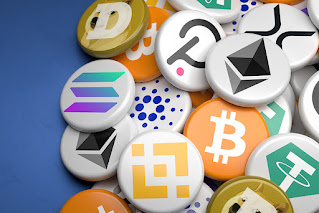Comprehensive Comparison Between Bitcoin and Altcoins: Exploring Unique Features and Characteristics
By Laurie Suarez www.crypto101bylauriesuarez.com
Introduction
Welcome to our comprehensive video presentation on the comparison
between Bitcoin and Altcoins. In this video, we'll take an in-depth look at the
unique features, underlying technologies, performance parameters, user
benefits, drawbacks, and more that distinguish these two categories of
cryptocurrencies. Let's dive into the details of this comprehensive comparison
matrix.
A Brief Overview
Let's start with a brief overview of Bitcoin and Altcoins. Bitcoin,
introduced by Satoshi Nakamoto in 2008, holds the distinction of being the
first cryptocurrency. It operates on a decentralized, open-source blockchain,
functioning as a digital peer-to-peer currency for secure and permissionless
transactions. On the other hand, Altcoins encompass all cryptocurrencies other
than Bitcoin, offering alternatives with varying features, functionalities, and
use cases.
Key Characteristics
Bitcoin's key characteristics include a limited supply of 21 million
coins, a Proof of Work (PoW) consensus mechanism, high security, and a
narrative of being a store of value akin to digital gold. In contrast, Altcoins
showcase diverse supply mechanisms, consensus models like PoW, PoS (Proof of
Stake), and DPoS (Delegated Proof of Stake), as well as distinct use cases such
as smart contracts, privacy features, and scalability enhancements.
Intrinsic Qualities
Bitcoin's intrinsic qualities lie in its immutability, censorship
resistance, limited supply that enhances scarcity value, and its recognized
brand identity. Altcoins, however, offer technological diversity and
innovation, specialized use cases that cater to unique needs, and the potential
for higher transaction throughput and scalability.
Underlying Technology
Bitcoin operates on blockchain technology, utilizing the Unspent
Transaction Output (UTXO) model. Its energy-intensive PoW consensus mechanism
secures the network, and it employs a basic scripting language for smart
contracts. Altcoins, on the other hand, feature diverse blockchain
technologies, such as Ethereum's EVM (Ethereum Virtual Machine), and employ
varying consensus mechanisms like PoS and DPoS. This diversity also enables more
advanced smart contract capabilities.
Performance Parameters
Bitcoin's performance parameters include limited transaction throughput,
high energy consumption due to PoW, and slower confirmation times during
network congestion. In contrast, Altcoins exhibit varying transaction
throughput based on their consensus mechanisms, lower energy consumption in
PoS-based systems, and potentially faster confirmation times.
Operational Efficiencies
Bitcoin boasts a proven track record, strong security, wide adoption,
and recognition. It's known for its high liquidity in markets. On the other
hand, Altcoins offer flexibility in addressing specific use cases, potential
for faster transaction processing, and lower energy consumption in PoS-based
systems.
User Benefits
Bitcoin's user benefits include security as an established store of
value, recognition as digital gold, and broad user adoption. Altcoins offer
tailored solutions for specific needs, the potential for faster and cheaper
transactions, and a platform for experimenting with new technologies and
features.
User Experience & Interface
In terms of user experience and interface, Bitcoin offers established
wallets and a relatively straightforward user experience. Altcoins, however,
vary depending on the specific altcoin, featuring different wallet options and
user interfaces.
Ease of Use
Bitcoin is generally user-friendly for basic transactions, although
newcomers may face a learning curve. Altcoins' ease of use varies, depending on
the specific altcoin and its unique features, with newcomers possibly needing
to learn about specific functionalities.
Customization Features
Bitcoin provides limited scripting language for customizing
transactions, with a focus on security and simplicity. On the other hand,
Altcoins offer customization features that vary, depending on the specific
altcoin. Ethereum, for instance, offers advanced smart contract scripting
capabilities.
Integration Capabilities
Bitcoin is widely integrated into various services and platforms, and
it's easier to find merchants accepting Bitcoin payments. Integration
capabilities for Altcoins depend on their adoption and use cases, with
Ethereum's ERC-20 standard enabling widespread tokenization.
Customer Support
Bitcoin benefits from established support channels, communities, and
extensive resources available online. Customer support for Altcoins varies
depending on the specific altcoin and its community, with resources potentially
being more limited for lesser-known altcoins.
Drawbacks & Challenges
While
Bitcoin has paved the way for the cryptocurrency industry, it's not without its
limitations. One of the prominent challenges is its transaction throughput,
which ranges from 7 to 10 transactions per second (TPS). This limited capacity
has led to congestion during peak usage times, resulting in slower confirmation
times and higher fees. Moreover, Bitcoin's Proof of Work (PoW) consensus
mechanism, while providing security, consumes a significant amount of energy,
contributing to environmental concerns.
Another
challenge lies in scalability. As the demand for Bitcoin transactions grows,
its limited block size and the time taken to mine blocks have become
bottlenecks in scaling the network to accommodate a larger user base.
Additionally, Bitcoin's dominance in the market often results in correlated
price movements across the cryptocurrency landscape, leading to market
volatility that affects both Bitcoin and Altcoins.
Altcoins'
Drawbacks & Challenges:
Altcoins,
despite their diversity and innovative features, also face their fair share of
challenges. One of the primary concerns is achieving widespread adoption and
recognition. While Altcoins bring new functionalities and use cases to the
table, they must contend with Bitcoin's strong brand identity and the challenge
of standing out in a crowded market.
Technical
vulnerabilities and upgrade challenges can also impact Altcoins. Hard forks and
debates over upgrades, similar to those seen in Bitcoin, can lead to network
splits and uncertainty among users. Furthermore, some Altcoins, particularly
those utilizing Proof of Stake (PoS) mechanisms, face potential centralization
risks due to the concentration of staking power in a few entities.
Regulatory
uncertainty is another obstacle faced by both Bitcoin and Altcoins. Evolving
regulations and differing approaches by governments worldwide can create a
challenging environment for these cryptocurrencies to operate within legal
frameworks.
In this
exploration of the challenges and drawbacks associated with both Bitcoin and Altcoins,
it's evident that no cryptocurrency is immune to limitations. Whether it's
Bitcoin's transaction throughput and scalability concerns or Altcoins' struggle
for recognition and technical challenges, each cryptocurrency must navigate a
complex landscape to achieve their intended goals. As the cryptocurrency
industry continues to evolve, addressing these challenges will be essential for
the sustainable growth and adoption of both Bitcoin and Altcoins.
Conclusion
In conclusion, this exhaustive comparison matrix offers a comprehensive
analysis of Bitcoin and Altcoins, covering their unique features, underlying
technologies, performance parameters, user benefits, drawbacks, and more. By
understanding their strengths, weaknesses, and overall value propositions,
you're better equipped to make informed decisions within the cryptocurrency
landscape.
Watch the Video by clicking here. Play Now
 |
| Comprehensive Comparison Between Bitcoin and Altcoins |


Comments
Post a Comment